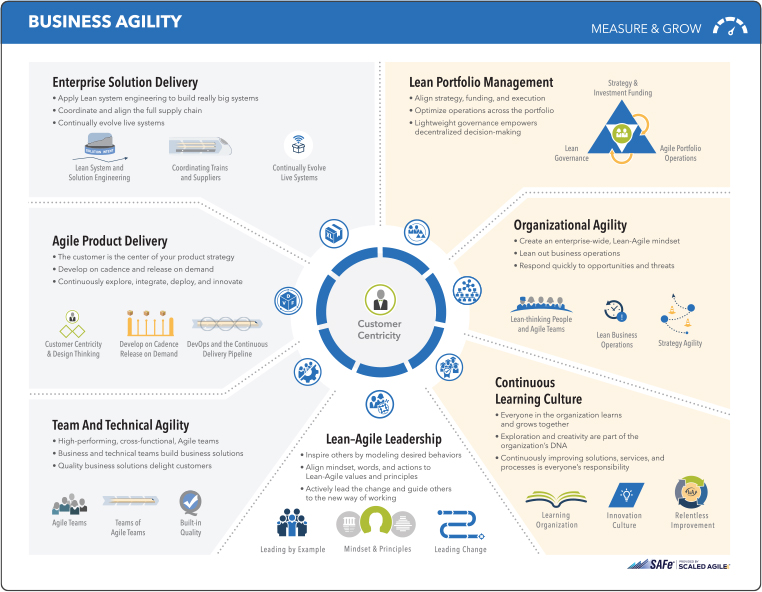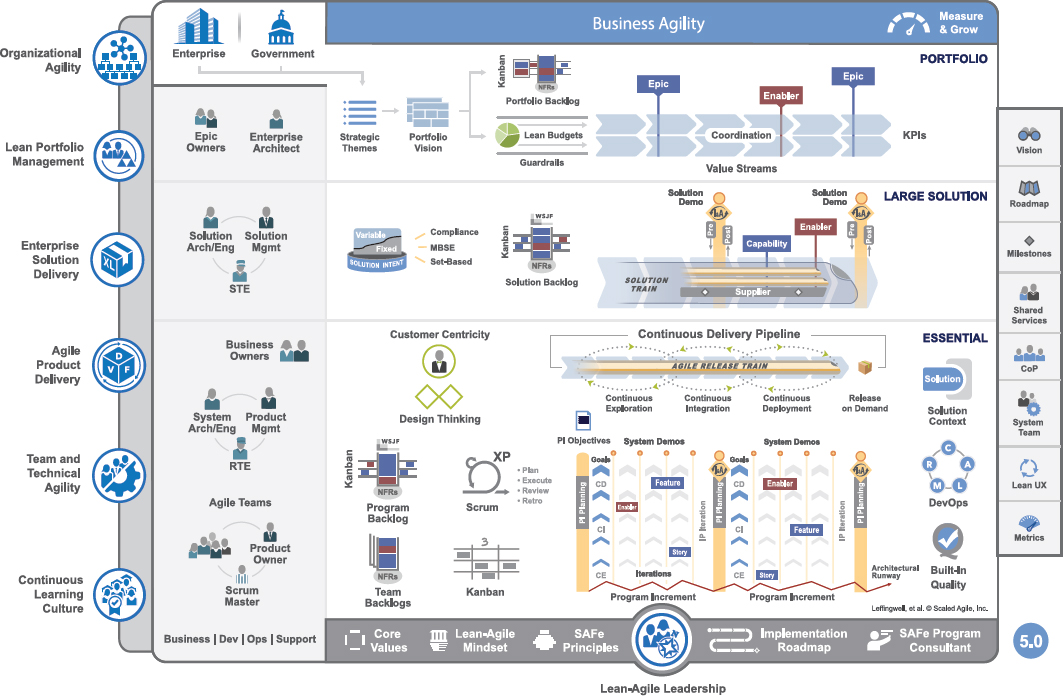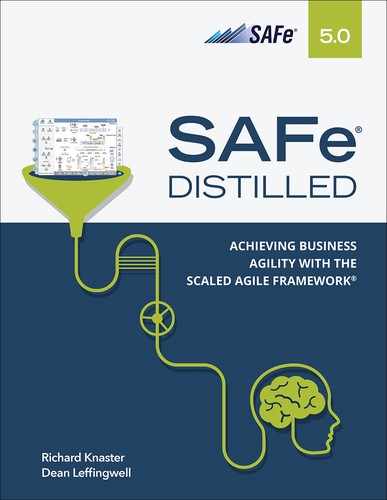2
Introduction to SAFe
“If you can’t describe what you are doing as a process, you don’t know what you’re doing.”
—W. Edwards Deming
In Chapter 1, we introduced the concept of business agility and its importance to competing in today’s fast-paced digital world. It explored the need for a dual operating system, one for stability and execution and another for innovation and growth. It introduced SAFe as the entrepreneurial and flexible second operating system that helps enterprises achieve the goals of stability, execution, and innovation. This chapter provides a brief overview of SAFe and discusses how it helps organizations achieve business agility.
What Is SAFe?
SAFe for Lean Enterprises is an online knowledge base of proven, integrated principles, practices, and guidance that brings the power of Lean, Agile, and DevOps to the people building the world’s most important systems. The goal of SAFe is to help enterprises become thriving digital age businesses that deliver competitive systems and solutions to its customers in the shortest sustainable lead time.
Why Implement SAFe?
“We had multiple waterfall efforts, third-party integration, and a hard, regulatory mandate that made coordination and execution exceptionally difficult. SAFe provided the agility, visibility, and transparency needed to ensure we could integrate with the numerous other efforts, get predictable in our delivery, and ensure timelines are met.”
—David McMunn, the director of Fannie Mae’s Agile Center of Excellence (COE)
As described in Chapter 1, enterprises have to learn how to adapt quickly to the digital age or become extinct, no matter their size, their strength, or how smart they are. Business agility isn’t an option; it’s a business imperative. Even businesses that don’t consider themselves Information Technology (IT) or software companies are now all highly dependent on their ability to rapidly produce new, high-quality, innovative technology-based products and services.
The mission of Scaled Agile Inc. (SAI) is to help enterprises thrive in the digital age. We do that through the development and publication of the SAFe knowledge base, as well as accompanying certification, training, courseware, community resources, and a global network of more than 300 tooling and service partners.
Improving System Development Outcomes
SAFe draws from four primary bodies of knowledge—Agile, DevOps, Lean product development, and systems thinking—and leverages more than a decade of real-world customer experience. It helps enterprises answer the following types of questions:
How do we align technology development to business strategy?
How do we deliver new value on a predictable schedule so that the rest of the business can plan?
How do we improve the quality of our solutions and delight our customers?
How do we scale Agile practices across the enterprise to deliver better results?
How do we reorganize around value to avoid the delays inherent in a traditional, functional structure?
How do we create an environment that fosters collaboration, innovation, and relentless improvement?
How do we encourage people to take risks, think creatively, and embrace continuous learning?
By adopting SAFe—and applying its well-described set of values, principles, and practices—the enterprise can address these questions and realize greater business and individual benefits.
SAFe enables business agility and improves business outcomes for organizations of all sizes across the world. It has produced dramatic improvements in time to market, employee engagement, higher quality, higher customer satisfaction, and overall improved economic outcomes. It also helps create cultures that are more productive, rewarding, and fun.
Figure 2-1 highlights these benefits as derived directly from customer case studies.

Figure 2-1. SAFe business benefits (source: scaledagile.com/customer-stories)
The Big Picture
Before an enterprise can gain the substantial business benefits shown in Figure 2-1, it has to transform itself into a Lean-Agile enterprise. This transformation requires developing enterprise core competencies that enable a new style of leadership, new ways of thinking and working, and a culture focused on value delivery and continuous improvement.
SAFe’s extensive body of knowledge describes the roles, responsibilities, artifacts, and activities necessary to implement enterprise-scale Lean-Agile development. SAFe synchronizes alignment, collaboration, and delivery for large numbers of Agile business and technical teams. Scalable and configurable, SAFe supports smaller-scale solutions employing 50–125 practitioners, as well as complex systems that require thousands of people to build and maintain.
The SAFe website features an interactive Big Picture graphic with tabs to select each configuration, as shown in Figure 2-2.

Figure 2-2. The SAFe Big Picture
This graphic provides a visual overview and is the primary user interface to the SAFe knowledge base. Each icon of the image is clickable and provides an entry to the extensive SAFe guidance, which includes the following: the seven core competencies of the Lean enterprise, the four configurations that support a full range of development and business environments, and the foundational principles, values, mindset, roles, artifacts, and implementation elements that make up SAFe. Each of these elements is described next.
Overview Tab
SAFe includes an Overview tab, as illustrated in Figure 2-2. When you click on it, the image in Figure 2-3 is displayed. It provides a simplified view of SAFe’s seven core competencies and the twenty-one dimensions that enable business agility. The customer is the focal point for all competencies, while Lean-Agile leadership is foundational. This overview is a useful tool for providing an initial orientation to SAFe and for framing executive briefings.

Figure 2-3. The SAFe Overview tab
The road to business agility is a journey, not a destination. To this end, the Measure & Grow link (top right) offers access to a guidance article, which describes how SAFe portfolios evaluate their progress toward business agility and determine the next improvement steps. This topic is further explored in Chapter 16, Measure, Grow, and Accelerate.
The seven core competencies are the ‘primary lens’ for understanding and implementing SAFe. Each is a set of related knowledge, skills, and behaviors, which together enable enterprises to achieve business agility by delivering the best quality and value in the shortest sustainable lead time. The following is a summary of each:
Lean-Agile Leadership describes how Lean-Agile leaders drive and sustain organizational change by empowering individuals and teams to reach their highest potential.
Team and Technical Agility describes the critical skills and Lean-Agile principles and practices that high-performing Agile teams use to create innovative business solutions for their customers.
Agile Product Delivery is a customer-centric approach to defining, building, and releasing a continuous flow of valuable products and services to customers and users.
Enterprise Solution Delivery describes how to apply Lean-Agile principles and practices to the development of the world’s largest and most sophisticated software applications, networks, and cyber-physical systems.
Lean Portfolio Management aligns strategy and execution by applying Lean and systems thinking approaches to strategy and investment funding, Agile portfolio operations, and governance.
Organizational Agility describes how Lean-thinking people and Agile teams optimize their business processes, evolve strategy with clear and decisive new commitments, and quickly adapt the organization as needed to capitalize on new opportunities.
Continuous Learning Culture is a set of values and practices that encourage individuals—and the enterprise as a whole—to continually increase knowledge, competence, performance, and innovation.
Each core competency has an assessment that explores areas of opportunity and concern along its three dimensions. These assessments are located at the bottom of each competency article on the SAFe website. To obtain guidance on how to improve, each assessment has a set of recommendations or ‘grows,’ which are also linked from the individual competency articles.
SAFe Configurations
Configurable and scalable, SAFe allows each organization to adapt the framework to its own business needs (Figure 2-4). With four out-of-the-box configurations, SAFe supports the full spectrum of solutions, from those requiring a small number of teams to those complex systems that require hundreds—and even thousands—of people to build and deliver.

Figure 2-4. SAFe configurations
The configurations can be accessed with the tabs shown in Figure 2-2, and each configuration is briefly described next.
Essential SAFe
Essential SAFe (Figure 2-5) contains the minimal set of roles, events, and artifacts required to continuously deliver business solutions. It is built on the principles and practices found in the competencies of Lean-Agile leadership, team and technical agility, and Agile product delivery. It is the basic building block for all other SAFe configurations and is the simplest starting point for implementation.

Figure 2-5. Essential SAFe
The Agile Release Train (ART) is a fundamental organizing structure in Essential SAFe, where Agile business and technical teams, key stakeholders, and other resources are dedicated to an important, ongoing solution mission. The ART’s long-lived, flow-based, self-organizing nature is what powers SAFe and ultimately enables business agility. Most trains are virtual organizations that cut across organizational and geographic boundaries.
Large Solution SAFe
Large Solution SAFe (Figure 2-6) describes additional roles, practices, and guidance to build and evolve the world’s largest applications, networks, and cyber-physical systems. It includes Essential SAFe and introduces the enterprise solution delivery competency, which supports those building the largest and most complex solutions that require multiple ARTs and suppliers but do not require portfolio-level considerations. Such solution development is common for industries such as aerospace and defense, automotive, and government, where the large solution—not portfolio governance—is the primary concern.

Figure 2-6. Large Solution SAFe configuration
The Solution Train, shown in the large solution level, is the organizational vehicle that coordinates the efforts of multiple ARTs and suppliers to deliver these large and complex systems. The value delivered by Solution Trains can range from core banking applications in global financial institutions to jet fighters and satellite systems.
Portfolio SAFe
The Portfolio SAFe (Figure 2-7) configuration is the minimum set of competencies and practices that can fully enable business agility, as indicated by the blue ‘Business Agility’ banner at the top. This banner also includes a link to ‘measure and grow’ for guidance on conducting SAFe business agility assessments. Portfolio SAFe includes the Essential SAFe competencies and adds the competencies of Lean portfolio management, organizational agility, and continuous learning culture.

Figure 2-7. Portfolio SAFe configuration
The configuration aligns portfolio execution to enterprise strategy and organizes development around the flow of value through one or more value streams. It provides principles and practices for portfolio strategy and investment funding, Agile portfolio operations, and Lean governance. It helps assure that the value stream and its trains are focused on building the right things with the appropriate level of investments needed to meet strategic objectives.
Full SAFe
Full SAFe (Figure 2-8) is the most comprehensive configuration, including all seven core competencies needed for business agility. It is used by the world’s largest enterprises to maintain portfolios of large and complex solutions. In some cases, multiple instances of various SAFe configurations may be required.

Figure 2-8. Full SAFe configuration
In addition to the four configurations, the framework includes SAFe for Government, which is a set of success patterns for implementing Lean-Agile practices in the public sector. It offers a landing page that hosts a series of government specific SAFe articles, and provides videos, events, and other resources.
You can find more information about the government specific practices at www.scaledagileframework.com/government/.
The Spanning Palette
The spanning palette contains various roles and artifacts that may apply to a specific team, ART, large solution, or portfolio context. An essential element of SAFe’s flexibility and configurability, the spanning palette permits organizations to apply only the items needed for their configuration.
Figure 2-9 illustrates two versions of the spanning palette.

Figure 2-9. Spanning palette
The small palette is used by the Essential SAFe configuration, while the larger one serves all other configurations. However, since SAFe is a framework, which is meant to be adapted to your context, enterprises can apply any of the elements from the larger spanning palette to Essential SAFe.
The following are brief descriptions of each spanning palette element:
Vision. The vision describes a future view of the solution to be developed, reflecting customer and stakeholder needs, as well as the features and capabilities that are proposed to address those needs.
Roadmap. The roadmap communicates planned ART and value stream deliverables and milestones over a timeline.
Milestones. A milestone is used to track progress toward a specific goal or event. SAFe describes fixed-date, Program Increment (PI), and learning milestones.
Shared Services. Shared services represent the specialty roles that are necessary for the success of an ART or Solution Train but that cannot be dedicated full-time to any specific train.
CoP. A Community of Practice (CoP) is an informal group of team members and other experts that has a mission of sharing practical knowledge in one or more relevant domains.
System Team. The system team is a special Agile team that provides assistance in building and using the continuous delivery pipeline and, where necessary, validating full end-to-end system performance.
Lean UX. Lean User Experience (UX) is the application of Lean principles to user experience design. It uses an iterative, hypothesis-driven approach to product development, through constant measurement and learning loops (build-measure-learn).
Metrics. The primary measure in SAFe is the objective evaluation of working solutions. Moreover, SAFe defines some additional intermediate and long-term measures that teams, ARTs, and portfolios can use to measure progress.
The Foundation
The foundation contains the supporting principles, values, mindset, implementation guidance, and leadership roles needed to deliver value successfully at scale. Each foundation element, as shown in Figure 2-10, is briefly described next.
Lean-Agile leaders. Management has the ultimate responsibility for business outcomes. Leaders are trained in SAFe and in turn become trainers of these leaner and more agile ways of thinking and operating. To this end, SAFe describes a new style of leadership exhibited by the enterprise’s new ‘Lean-thinking manager-teachers.’
Core values. Four core values of alignment, built-in quality, transparency, and program execution define the belief and value system for SAFe.
Lean-Agile mindset. Lean-Agile leaders are lifelong learners and teachers who understand, embrace, and foster Lean and Agile principles and practices across the enterprise.
SAFe principles. SAFe practices are grounded in 10 principles that synthesize Agile methods, Lean product development, DevOps, systems thinking, and decades of field experience.
Implementation roadmap. Implementing the changes necessary to become a Lean-Agile technology enterprise is a substantial change for most companies. SAFe provides an implementation roadmap to help guide organizations on this journey
SAFe Program Consultants (SPCs). SPCs are certified change agents who combine their technical knowledge of SAFe with an intrinsic motivation to improve their company’s software and systems development processes.

Figure 2-10. SAFe foundation
The SAFe Implementation Roadmap
The SAFe implementation roadmap (Figure 2-11) provides a proven method for achieving the desired organizational change. It is generally based on the principles in John P. Kotter’s eight-step model for leading change. As leaders strive for successful change, this roadmap helps them ‘know the way.’

Figure 2-11. SAFe implementation roadmap
While no two SAFe adoptions are identical and they rarely follow a perfectly sequential step-by-step process, businesses typically get the best results when they follow a path similar to that shown in the SAFe implementation roadmap.
Measure and Grow
Measure and grow is the term we use to describe how SAFe portfolios evaluate their progress on the journey toward business agility and determine the next improvement steps.
It describes how to measure the current state of a portfolio and grow to improve overall business outcomes.
Measure and grow are accomplished via two separate assessment mechanisms, designed for significantly different audiences and different purposes.
The SAFe Business Agility Assessment is designed for LPM and portfolio stakeholders to assess their overall progress on the ultimate goal of true business agility.
The SAFe Core Competency Assessments are used to help teams and trains improve on the technical and business practices they need to help the portfolio achieve that larger goal.
Each assessment follows a standard process pattern of running the assessment, analyzing the results, taking action, and celebrating the victories.
Summary
To survive in the digital age, enterprises must adopt new ways of working based on the best, proven, and most contemporary technological and business practices available. SAFe for Lean Enterprises brings the power of Lean, Agile, DevOps, and systems thinking to the leaders and practitioners that are responsible for building the next generation of business solutions. Scalable and configurable, SAFe also provides an implementation roadmap to guide the enterprises down the journey of achieving the seven core competencies that are necessary for achieving true business agility. Business outcomes include faster time to market, higher quality and productivity, and higher levels of employee engagement and motivation.
In this way, successful adoption of SAFe helps enterprises thrive in the digital age by delivering innovative technical and business solutions faster than the competition.
